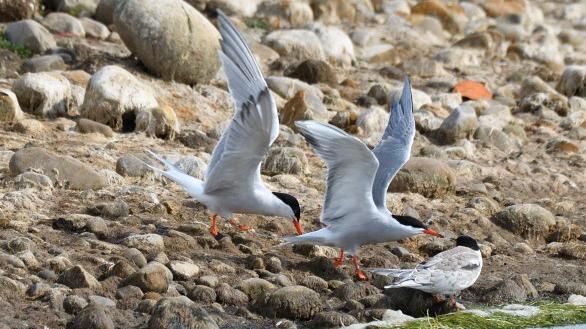Breeding boost for under-threat seabird colony

Common terns are found along the Lune estuary saltmarshes
At a glance
A new marine platform in Lancashire's Lune estuary will help nesting common terns
It was made from upcycled and salvaged marine pontoons, floats and timbers
The platform has been installed at Conder Pools Nature Reserve near Lancaster
- Published
An under-threat colony of common terns in Lancashire could be boosted by the creation of a special new breeding platform.
It is hoped the feature in the Lune estuary will increase the number of nesting birds.
Several hundred pairs of common tern used to breed on the estuary's saltmarshes.
But the seabird colony collapsed in 2008 due to factors including recreational disturbance, predation by foxes and habitat erosion, the RSPB said.
A small population nesting at Conder Pool is all that remains of the once thriving colony.
The platform has been installed at Conder Pools Nature Reserve in Conder Green, just south of Lancaster.
The platform was assembled by RSPB staff and volunteers
It is made from upcycled and salvaged marine pontoons, floats and timbers and was assembled by RSPB staff and volunteers from Fylde Bird Club in time for this year’s breeding season.
Calum Booth, an RSPB conservation officer, said: “This new platform will provide a safe, secure nesting area for the species and we hope that the population in the Lune estuary can now start to recover.”
Dave Lewis, the site manager of Glasson Dock Marina and Boat Yard, said: "The birds are one of the things that makes the place special to our residents and visitors, so when we were approached by the RSPB about recycling some of our old dock pontoons into nesting rafts for seabirds like common tern, we were more than happy to help."
Common terns
A small, agile seabird that breeds in the UK and spends the winter in southern Europe and western Africa
Identified by their black heads, red bills and sharp, angular flight and characteristic high-pitched calls
They start nesting in May and chicks usually hatch later that month or in early June
The chicks fledge in July and August and leave to migrate south for the winter in late summer
Source: RSPB
Why not follow BBC North West on Facebook, external, Twitter, external and Instagram, external? You can also send story ideas to northwest.newsonline@bbc.co.uk, external
Related Internet Links
- Published6 September 2019
- Published16 January 2020